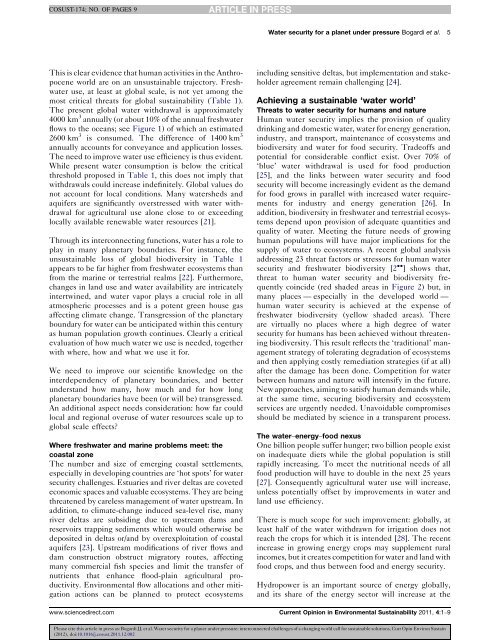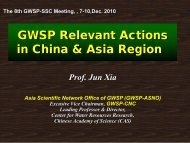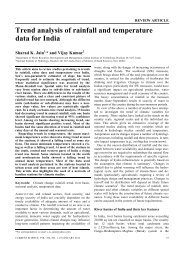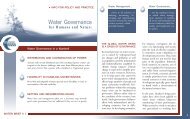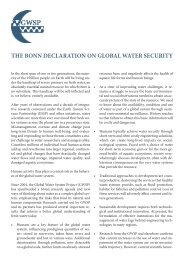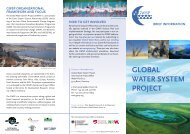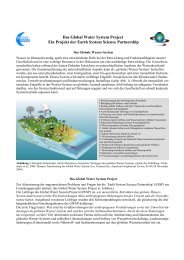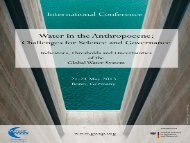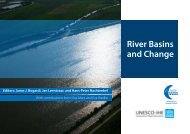Water security for a planet under pressure: interconnected ... - GWSP
Water security for a planet under pressure: interconnected ... - GWSP
Water security for a planet under pressure: interconnected ... - GWSP
Create successful ePaper yourself
Turn your PDF publications into a flip-book with our unique Google optimized e-Paper software.
COSUST-174; NO. OF PAGES 9<br />
<strong>Water</strong> <strong>security</strong> <strong>for</strong> a <strong>planet</strong> <strong>under</strong> <strong>pressure</strong> Bogardi et al. 5<br />
This is clear evidence that human activities in the Anthropocene<br />
world are on an unsustainable trajectory. Freshwater<br />
use, at least at global scale, is not yet among the<br />
most critical threats <strong>for</strong> global sustainability (Table 1).<br />
The present global water withdrawal is approximately<br />
4000 km 3 annually (or about 10% of the annual freshwater<br />
flows to the oceans; see Figure 1) of which an estimated<br />
2600 km 3 is consumed. The difference of 1400 km 3<br />
annually accounts <strong>for</strong> conveyance and application losses.<br />
The need to improve water use efficiency is thus evident.<br />
While present water consumption is below the critical<br />
threshold proposed in Table 1, this does not imply that<br />
withdrawals could increase indefinitely. Global values do<br />
not account <strong>for</strong> local conditions. Many watersheds and<br />
aquifers are significantly overstressed with water withdrawal<br />
<strong>for</strong> agricultural use alone close to or exceeding<br />
locally available renewable water resources [21].<br />
Through its interconnecting functions, water has a role to<br />
play in many <strong>planet</strong>ary boundaries. For instance, the<br />
unsustainable loss of global biodiversity in Table 1<br />
appears to be far higher from freshwater ecosystems than<br />
from the marine or terrestrial realms [22]. Furthermore,<br />
changes in land use and water availability are intricately<br />
intertwined, and water vapor plays a crucial role in all<br />
atmospheric processes and is a potent green house gas<br />
affecting climate change. Transgression of the <strong>planet</strong>ary<br />
boundary <strong>for</strong> water can be anticipated within this century<br />
as human population growth continues. Clearly a critical<br />
evaluation of how much water we use is needed, together<br />
with where, how and what we use it <strong>for</strong>.<br />
We need to improve our scientific knowledge on the<br />
interdependency of <strong>planet</strong>ary boundaries, and better<br />
<strong>under</strong>stand how many, how much and <strong>for</strong> how long<br />
<strong>planet</strong>ary boundaries have been (or will be) transgressed.<br />
An additional aspect needs consideration: how far could<br />
local and regional overuse of water resources scale up to<br />
global scale effects?<br />
Where freshwater and marine problems meet: the<br />
coastal zone<br />
The number and size of emerging coastal settlements,<br />
especially in developing countries are ‘hot spots’ <strong>for</strong> water<br />
<strong>security</strong> challenges. Estuaries and river deltas are coveted<br />
economic spaces and valuable ecosystems. They are being<br />
threatened by careless management of water upstream. In<br />
addition, to climate-change induced sea-level rise, many<br />
river deltas are subsiding due to upstream dams and<br />
reservoirs trapping sediments which would otherwise be<br />
deposited in deltas or/and by overexploitation of coastal<br />
aquifers [23]. Upstream modifications of river flows and<br />
dam construction obstruct migratory routes, affecting<br />
many commercial fish species and limit the transfer of<br />
nutrients that enhance flood-plain agricultural productivity.<br />
Environmental flow allocations and other mitigation<br />
actions can be planned to protect ecosystems<br />
including sensitive deltas, but implementation and stakeholder<br />
agreement remain challenging [24].<br />
Achieving a sustainable ‘water world’<br />
Threats to water <strong>security</strong> <strong>for</strong> humans and nature<br />
Human water <strong>security</strong> implies the provision of quality<br />
drinking and domestic water, water <strong>for</strong> energy generation,<br />
industry, and transport, maintenance of ecosystems and<br />
biodiversity and water <strong>for</strong> food <strong>security</strong>. Tradeoffs and<br />
potential <strong>for</strong> considerable conflict exist. Over 70% of<br />
‘blue’ water withdrawal is used <strong>for</strong> food production<br />
[25], and the links between water <strong>security</strong> and food<br />
<strong>security</strong> will become increasingly evident as the demand<br />
<strong>for</strong> food grows in parallel with increased water requirements<br />
<strong>for</strong> industry and energy generation [26]. In<br />
addition, biodiversity in freshwater and terrestrial ecosystems<br />
depend upon provision of adequate quantities and<br />
quality of water. Meeting the future needs of growing<br />
human populations will have major implications <strong>for</strong> the<br />
supply of water to ecosystems. A recent global analysis<br />
addressing 23 threat factors or stressors <strong>for</strong> human water<br />
<strong>security</strong> and freshwater biodiversity [2 ] shows that,<br />
threat to human water <strong>security</strong> and biodiversity frequently<br />
coincide (red shaded areas in Figure 2) but, in<br />
many places — especially in the developed world —<br />
human water <strong>security</strong> is achieved at the expense of<br />
freshwater biodiversity (yellow shaded areas). There<br />
are virtually no places where a high degree of water<br />
<strong>security</strong> <strong>for</strong> humans has been achieved without threatening<br />
biodiversity. This result reflects the ‘traditional’ management<br />
strategy of tolerating degradation of ecosystems<br />
and then applying costly remediation strategies (if at all)<br />
after the damage has been done. Competition <strong>for</strong> water<br />
between humans and nature will intensify in the future.<br />
New approaches, aiming to satisfy human demands while,<br />
at the same time, securing biodiversity and ecosystem<br />
services are urgently needed. Unavoidable compromises<br />
should be mediated by science in a transparent process.<br />
The water–energy–food nexus<br />
One billion people suffer hunger; two billion people exist<br />
on inadequate diets while the global population is still<br />
rapidly increasing. To meet the nutritional needs of all<br />
food production will have to double in the next 25 years<br />
[27]. Consequently agricultural water use will increase,<br />
unless potentially offset by improvements in water and<br />
land use efficiency.<br />
There is much scope <strong>for</strong> such improvement: globally, at<br />
least half of the water withdrawn <strong>for</strong> irrigation does not<br />
reach the crops <strong>for</strong> which it is intended [28]. The recent<br />
increase in growing energy crops may supplement rural<br />
incomes, but it creates competition <strong>for</strong> water and land with<br />
food crops, and thus between food and energy <strong>security</strong>.<br />
Hydropower is an important source of energy globally,<br />
and its share of the energy sector will increase at the<br />
www.sciencedirect.com Current Opinion in Environmental Sustainability 2011, 4:1–9<br />
Please cite this article in press as: Bogardi JJ, et al. <strong>Water</strong> <strong>security</strong> <strong>for</strong> a <strong>planet</strong> <strong>under</strong> <strong>pressure</strong>: <strong>interconnected</strong> challenges of a changing world call <strong>for</strong> sustainable solutions, Curr Opin Environ Sustain<br />
(2012), doi:10.1016/j.cosust.2011.12.002


